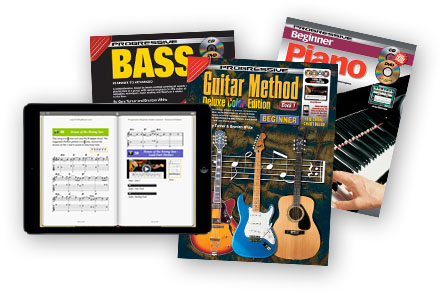<< First < Previous | Intro 1 2 3 4 5 | Next > Last >>
Back to Table of Contents
Eighth Note Rhythms
All the rhythm patterns you have played so far involved playing a downward strum (  ), on the 1st, 2nd, 3rd or 4th beat. To make rhythm patterns more interesting, eighth note rhythm patterns can be used. An eighth note rhythm is a combination of a down and an up strum within one beat. The down strum “on the beat” is played louder than the up strum which is “off the beat” (the “+” section of the count). An up strum is indicated by a
), on the 1st, 2nd, 3rd or 4th beat. To make rhythm patterns more interesting, eighth note rhythm patterns can be used. An eighth note rhythm is a combination of a down and an up strum within one beat. The down strum “on the beat” is played louder than the up strum which is “off the beat” (the “+” section of the count). An up strum is indicated by a  , and is played on the “and” section of the count. Start the up strum on the first (thinnest) string and strum upwards. Instead of hitting all six strings, the up strum sounds best with only the first three or four strings being struck. As you continue the up strum, your hand will naturally move up away from the strings and be ready for the next down strum.
, and is played on the “and” section of the count. Start the up strum on the first (thinnest) string and strum upwards. Instead of hitting all six strings, the up strum sounds best with only the first three or four strings being struck. As you continue the up strum, your hand will naturally move up away from the strings and be ready for the next down strum.
Play the following rhythm pattern, which has eighth note strums on the second beat consisting of a down strum on the “2” count and an up strum on the “+” section of the count. There are eight eighth note strums in one bar of  time.
time.
| 14 |
Video
Play the following patterns holding a G chord:
| 15 |
Video
| 16 |
Video
| 17 |
Video
| 18 |
Video
| 19 |
Video
| 20 |
Video
| 21 |
Video
| 22 |
Video
The 12 Bar Blues Progression
The 12 Bar Blues is a pattern of chords which repeats every 12 bars. There are hundreds of well known songs based on this chord progression, i.e., they contain basically the same chords in the same order. The 12 Bar Blues is commonly used in Rock music and is the basis of Blues music.
Here are some well known Rock ‘n’ Roll songs which use this 12 bar chord pattern.
Songs using the 12 Bar Blues Progression
- Original Batman TV Theme
- Hound Dog – Elvis Presley
- Rock Around the Clock – Bill Haley
- Roll Over Beethoven – Chuck Berry
- Blue Suede Shoes – Elvis Presley
- In the Mood – Glenn Miller
- Shake, Rattle and Roll – Bill Haley
- Barbara Ann – The Beach Boys
- Johnny B Goode – Chuck Berry
- Dizzy Miss Lizzy – The Beatles
- Surfin’ USA – The Beach Boys
- Good Golly Miss Molly – Little Richard
| 23 | 12 Bar Blues in the Key of G Major |
The following 12 Bar Blues is in the key of G major and uses some of the chords you have learned so far. When a song is said to be in the key of G major, it means that the most important chord (and usually the first chord) is the G chord.
This pattern of chords will probably sound familiar to you. Instead of writing a chord symbol above each bar of music, it is common to only write a chord symbol when the chord changes, e.g., the first four bars of this blues are a G chord. End this 12 Bar Blues by playing a G chord. Use alternate picking when playing the notes.
| 23 | 12 Bar Blues in the Key of G Major (Lead Part Notes) |
Video
| 23 | 12 Bar Blues in the Key of G Major (Rhythm Part Chords) |
Video
<< First < Previous | Intro 1 2 3 4 5 | Next > Last >>
Back to Table of Contents


































